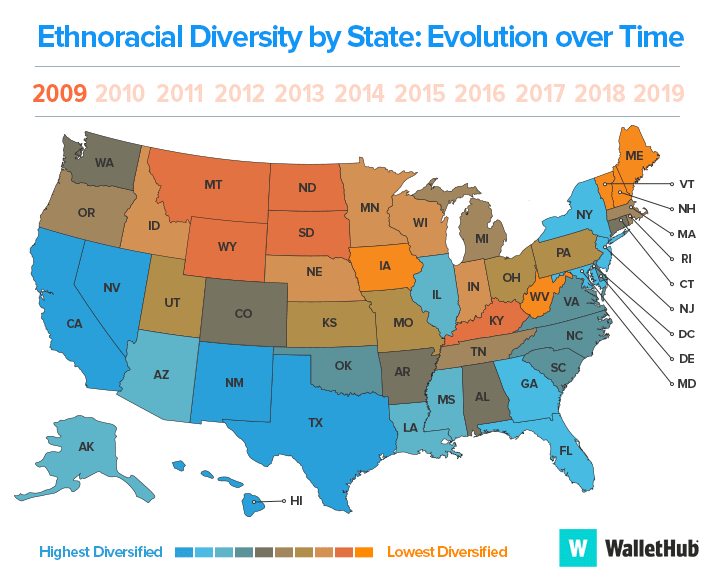
Texas is 2021’s second most diverse state in America
Reprinted with permission from WalletHub
The American narrative is a story of diversity. Our history tells of many different peoples coming together from every walk of life to form what is today a complex tapestry of backgrounds. Our story will continue to advance that narrative in the decades to come. The U.S. Census Bureau predicts that by 2045 the U.S. will no longer have a single ethnic majority, currently non-Hispanic whites, and will grow increasingly more diverse in the years to follow.
This year, racial inequality has continued to be a prominent issue, including high-profile trials regarding police brutality. But while discussions on race are important, U.S. diversity spans far more than just racial lines. The U.S. population reflects a mix of not just races and ethnicities but also cultures, religions, economic statuses, educational backgrounds and other characteristics. These groups come together in everyday life, influencing and experiencing one another. However, some elements of society aren’t as diverse as others. For example, there are only 41 women among the CEOs of fortune 500 companies, and around 84 percent of those companies’ board members are white (including men and women).
Some U.S. states promote diversity more than others. In order to determine where idea and identity exchanges have occurred at the highest level — and where the population is relatively more homogeneous — WalletHub compared the 50 states across six key diversity categories. For a more local perspective on America’s ever-expanding diversity, we also conducted our analysis at the city level.
Most & Least Diverse States in the U.S.
| Overall Rank | State | Total Score | Socioeconomic Diversity | Cultural Diversity | Economic Diversity | Household Diversity | Religious Diversity | Political Diversity |
|---|---|---|---|---|---|---|---|---|
| 1 | California | 70.64 | 3 | 1 | 11 | 5 | 32 | 8 |
| 2 | Texas | 69.97 | 13 | 4 | 13 | 14 | 6 | 21 |
| 3 | Hawaii | 69.73 | 16 | 3 | 4 | 11 | 34 | 16 |
| 4 | New Jersey | 69.27 | 5 | 7 | 40 | 26 | 19 | 4 |
| 5 | New York | 69.14 | 8 | 8 | 37 | 6 | 21 | 6 |
| 6 | New Mexico | 69.10 | 40 | 6 | 5 | 4 | 22 | 36 |
| 7 | Maryland | 68.64 | 2 | 10 | 25 | 10 | 30 | 19 |
| 8 | Florida | 68.57 | 28 | 5 | 33 | 7 | 38 | 5 |
| 9 | Nevada | 68.43 | 29 | 2 | 43 | 2 | 45 | 11 |
| 10 | Arizona | 68.03 | 23 | 9 | 26 | 8 | 41 | 17 |
| 11 | Illinois | 67.96 | 12 | 12 | 38 | 23 | 7 | 2 |
| 12 | Virginia | 67.78 | 4 | 14 | 16 | 33 | 25 | 24 |
| 13 | Georgia | 67.67 | 19 | 13 | 14 | 9 | 16 | 35 |
| 14 | Connecticut | 67.12 | 6 | 15 | 45 | 28 | 27 | 7 |
| 15 | Alaska | 66.89 | 22 | 11 | 1 | 31 | 44 | 26 |
| 16 | Delaware | 66.44 | 14 | 17 | 41 | 18 | 35 | 29 |
| 17 | Washington | 66.41 | 10 | 16 | 15 | 35 | 43 | 9 |
| 18 | Colorado | 66.33 | 7 | 18 | 27 | 36 | 40 | 22 |
| 19 | Massachusetts | 66.26 | 1 | 19 | 50 | 23 | 33 | 2 |
| 20 | North Carolina | 66.21 | 26 | 21 | 28 | 22 | 26 | 32 |
| 21 | Oklahoma | 65.87 | 44 | 22 | 6 | 17 | 18 | 31 |
| 22 | Rhode Island | 65.60 | 11 | 20 | 49 | 11 | 36 | 1 |
| 23 | South Carolina | 65.30 | 35 | 23 | 21 | 13 | 14 | 41 |
| 24 | Louisiana | 65.27 | 46 | 25 | 12 | 3 | 3 | 44 |
| 25 | Kansas | 65.09 | 21 | 26 | 23 | 39 | 11 | 26 |
| 26 | Nebraska | 64.60 | 25 | 33 | 24 | 41 | 4 | 33 |
| 27 | Oregon | 64.55 | 20 | 24 | 20 | 29 | 48 | 23 |
| 28 | Minnesota | 64.39 | 15 | 36 | 44 | 44 | 5 | 15 |
| 29 | Pennsylvania | 64.29 | 24 | 32 | 47 | 32 | 10 | 13 |
| 30 | Mississippi | 64.24 | 49 | 27 | 10 | 1 | 14 | 47 |
| 31 | Alabama | 64.23 | 45 | 30 | 18 | 15 | 12 | 47 |
| 32 | Tennessee | 64.19 | 41 | 31 | 22 | 20 | 20 | 43 |
| 33 | Arkansas | 63.79 | 48 | 28 | 17 | 19 | 24 | 45 |
| 34 | Idaho | 63.42 | 43 | 35 | 7 | 48 | 13 | 45 |
| 35 | South Dakota | 63.40 | 39 | 42 | 8 | 43 | 2 | 50 |
| 36 | Missouri | 63.17 | 31 | 39 | 35 | 30 | 17 | 18 |
| 37 | Michigan | 63.13 | 32 | 34 | 48 | 25 | 31 | 10 |
| 38 | North Dakota | 63.11 | 27 | 43 | 9 | 49 | 1 | 38 |
| 39 | Wisconsin | 63.08 | 30 | 40 | 39 | 37 | 9 | 30 |
| 40 | Indiana | 62.86 | 38 | 37 | 46 | 27 | 29 | 20 |
| 41 | Ohio | 62.62 | 36 | 41 | 42 | 16 | 28 | 28 |
| 42 | Iowa | 62.62 | 33 | 45 | 31 | 45 | 8 | 11 |
| 43 | Utah | 62.36 | 18 | 29 | 30 | 50 | 49 | 49 |
| 44 | Wyoming | 62.24 | 37 | 38 | 2 | 47 | 37 | 40 |
| 45 | Kentucky | 61.82 | 47 | 46 | 29 | 21 | 23 | 39 |
| 46 | Montana | 61.71 | 42 | 44 | 3 | 46 | 39 | 42 |
| 47 | New Hampshire | 60.84 | 9 | 47 | 36 | 42 | 46 | 13 |
| 48 | Vermont | 60.42 | 17 | 48 | 34 | 40 | 47 | 34 |
| 49 | Maine | 58.91 | 34 | 49 | 32 | 38 | 50 | 25 |
| 50 | West Virginia | 58.59 | 50 | 50 | 19 | 34 | 42 | 37 |
Note: With the exception of “Total Score,” all of the columns in the table above depict the relative rank of that state, where a rank of 1 represents the most diversity.
Detailed Findings
| State | Household-Income Diversity | Educational-Attainment Diversity | Racial & Ethnic Diversity | Linguistic Diversity | Birthplace Diversity | Industry Diversity | Occupational Diversity | Worker-Class Diversity | Marital-Status Diversity | Generational Diversity | Household-Type Diversity | Household-Size Diversity | Religious Diversity | Political Diversity |
|---|---|---|---|---|---|---|---|---|---|---|---|---|---|---|
| Alabama | 45 | 30 | 23 | 47 | 43 | 19 | 11 | 23 | 6 | 22 | 39 | 48 | 12 | 44 |
| Alaska | 4 | 47 | 13 | 18 | 5 | 26 | 20 | 1 | 34 | 48 | 16 | 4 | 44 | 2 |
| Arizona | 29 | 18 | 11 | 8 | 3 | 9 | 30 | 31 | 14 | 17 | 9 | 12 | 41 | 34 |
| Arkansas | 48 | 44 | 27 | 36 | 30 | 32 | 3 | 19 | 8 | 32 | 36 | 40 | 24 | 38 |
| California | 12 | 2 | 2 | 1 | 24 | 1 | 36 | 16 | 33 | 36 | 38 | 2 | 32 | 32 |
| Colorado | 3 | 8 | 24 | 16 | 4 | 5 | 45 | 28 | 38 | 38 | 33 | 10 | 40 | 27 |
| Connecticut | 11 | 7 | 21 | 13 | 19 | 45 | 47 | 35 | 28 | 8 | 25 | 20 | 27 | 22 |
| Delaware | 8 | 21 | 15 | 22 | 8 | 30 | 38 | 37 | 20 | 10 | 28 | 26 | 35 | 16 |
| Florida | 35 | 22 | 8 | 7 | 2 | 11 | 27 | 41 | 3 | 1 | 12 | 42 | 38 | 5 |
| Georgia | 31 | 13 | 9 | 21 | 16 | 4 | 28 | 30 | 16 | 44 | 30 | 14 | 16 | 25 |
| Hawaii | 7 | 27 | 1 | 9 | 13 | 17 | 23 | 4 | 36 | 2 | 47 | 3 | 34 | 4 |
| Idaho | 38 | 46 | 41 | 28 | 12 | 6 | 8 | 14 | 49 | 45 | 49 | 16 | 13 | 49 |
| Illinois | 15 | 11 | 12 | 11 | 38 | 22 | 34 | 47 | 30 | 24 | 20 | 18 | 7 | 19 |
| Indiana | 34 | 39 | 35 | 31 | 40 | 42 | 7 | 50 | 19 | 40 | 19 | 24 | 29 | 28 |
| Iowa | 24 | 48 | 45 | 33 | 44 | 31 | 14 | 28 | 43 | 34 | 34 | 35 | 8 | 6 |
| Kansas | 27 | 20 | 31 | 24 | 25 | 27 | 32 | 18 | 42 | 42 | 42 | 25 | 11 | 31 |
| Kentucky | 44 | 34 | 44 | 46 | 41 | 29 | 10 | 34 | 11 | 31 | 22 | 29 | 23 | 34 |
| Louisiana | 47 | 32 | 16 | 35 | 50 | 13 | 5 | 22 | 2 | 37 | 3 | 32 | 3 | 42 |
| Maine | 33 | 33 | 50 | 43 | 33 | 47 | 31 | 15 | 25 | 3 | 11 | 47 | 50 | 24 |
| Maryland | 10 | 4 | 5 | 15 | 9 | 35 | 49 | 5 | 26 | 25 | 37 | 9 | 30 | 16 |
| Massachusetts | 19 | 1 | 25 | 10 | 29 | 50 | 50 | 39 | 31 | 13 | 13 | 13 | 33 | 32 |
| Michigan | 32 | 35 | 29 | 30 | 49 | 44 | 19 | 49 | 21 | 18 | 10 | 28 | 31 | 11 |
| Minnesota | 6 | 23 | 38 | 23 | 39 | 37 | 40 | 45 | 47 | 33 | 41 | 19 | 5 | 13 |
| Mississippi | 50 | 41 | 18 | 49 | 47 | 33 | 1 | 9 | 1 | 39 | 15 | 39 | 14 | 28 |
| Missouri | 36 | 31 | 37 | 42 | 37 | 25 | 22 | 40 | 18 | 21 | 21 | 33 | 17 | 30 |
| Montana | 40 | 40 | 46 | 48 | 18 | 8 | 21 | 6 | 35 | 16 | 27 | 49 | 39 | 6 |
| Nebraska | 18 | 29 | 34 | 27 | 34 | 14 | 24 | 26 | 46 | 46 | 40 | 21 | 4 | 25 |
| Nevada | 23 | 36 | 3 | 6 | 1 | 41 | 6 | 44 | 5 | 27 | 1 | 8 | 45 | 20 |
| New Hampshire | 2 | 16 | 47 | 34 | 15 | 39 | 42 | 33 | 40 | 7 | 46 | 23 | 46 | 44 |
| New Jersey | 17 | 5 | 6 | 3 | 17 | 28 | 46 | 38 | 39 | 14 | 48 | 6 | 19 | 10 |
| New Mexico | 46 | 19 | 10 | 4 | 14 | 34 | 25 | 2 | 4 | 29 | 2 | 36 | 22 | 21 |
| New York | 26 | 3 | 7 | 5 | 35 | 46 | 44 | 20 | 23 | 11 | 5 | 11 | 21 | 9 |
| North Carolina | 39 | 15 | 17 | 25 | 21 | 21 | 29 | 32 | 17 | 26 | 29 | 31 | 26 | 16 |
| North Dakota | 13 | 45 | 43 | 44 | 32 | 23 | 16 | 10 | 48 | 47 | 8 | 43 | 1 | 48 |
| Ohio | 37 | 37 | 36 | 38 | 48 | 36 | 26 | 46 | 12 | 19 | 6 | 41 | 28 | 14 |
| Oklahoma | 43 | 38 | 19 | 29 | 28 | 2 | 9 | 11 | 10 | 41 | 24 | 22 | 18 | 23 |
| Oregon | 16 | 17 | 30 | 19 | 10 | 15 | 35 | 21 | 27 | 9 | 14 | 15 | 48 | 1 |
| Pennsylvania | 28 | 25 | 32 | 26 | 46 | 38 | 33 | 48 | 22 | 5 | 18 | 34 | 10 | 12 |
| Rhode Island | 20 | 10 | 26 | 12 | 23 | 48 | 39 | 42 | 13 | 6 | 4 | 27 | 36 | 47 |
| South Carolina | 42 | 26 | 20 | 40 | 22 | 16 | 12 | 25 | 7 | 15 | 26 | 45 | 15 | 44 |
| South Dakota | 30 | 43 | 40 | 41 | 36 | 12 | 15 | 8 | 44 | 43 | 35 | 44 | 2 | 41 |
| Tennessee | 41 | 28 | 28 | 39 | 27 | 18 | 13 | 24 | 15 | 23 | 31 | 30 | 20 | 37 |
| Texas | 22 | 9 | 4 | 2 | 26 | 3 | 17 | 27 | 29 | 49 | 43 | 5 | 6 | 39 |
| Utah | 1 | 24 | 33 | 20 | 31 | 10 | 37 | 36 | 50 | 50 | 50 | 1 | 49 | 39 |
| Vermont | 25 | 12 | 49 | 45 | 20 | 49 | 43 | 13 | 24 | 12 | 7 | 46 | 47 | 3 |
| Virginia | 9 | 6 | 14 | 17 | 11 | 20 | 48 | 7 | 32 | 28 | 45 | 17 | 25 | 14 |
| Washington | 5 | 14 | 22 | 14 | 7 | 7 | 41 | 17 | 37 | 30 | 32 | 7 | 43 | 6 |
| West Virginia | 49 | 49 | 48 | 50 | 42 | 43 | 4 | 12 | 9 | 4 | 23 | 50 | 42 | 43 |
| Wisconsin | 21 | 42 | 39 | 32 | 45 | 40 | 18 | 43 | 41 | 20 | 17 | 37 | 9 | 36 |
| Wyoming | 14 | 50 | 42 | 37 | 6 | 24 | 2 | 3 | 45 | 35 | 44 | 38 | 37 | 50 |
Note: All of the columns in the table above depict the relative rank of that state, where a rank of 1 represents the most diversity.







